Podcast: Play in new window | Download
Subscribe: Apple Podcasts | RSS
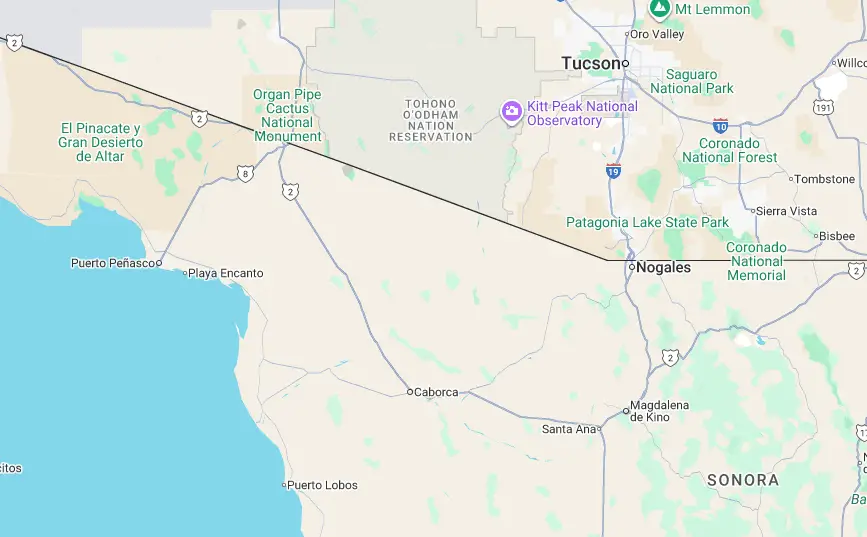 In the heart of the Sonoran Desert, less than 10 miles west of Caborca, Sonora, the La Proveedora petroglyph site stands as a monumental record of prehistoric artistry. Nestled within the La Proveedora and San José hills of the Rancho Puerto Blanco Ejido, this expansive collection of roughly 5,300 to 6,000 rock engravings represents the largest concentration of petroglyphs in Latin America. Created between 600 B.C. and A.D. 1400, these carvings—etched into basalt outcrops—reflect the cultural practices of the Hohokam, with possible contributions from the ancient Puebloans or Anasazi, the Mogollon, and the Tohono O’odham peoples. The motifs, encompassing human figures, animals, and geometric patterns, offer insights into social organization, spiritual beliefs, and trade networks that spanned the prehistoric Southwest.
In the heart of the Sonoran Desert, less than 10 miles west of Caborca, Sonora, the La Proveedora petroglyph site stands as a monumental record of prehistoric artistry. Nestled within the La Proveedora and San José hills of the Rancho Puerto Blanco Ejido, this expansive collection of roughly 5,300 to 6,000 rock engravings represents the largest concentration of petroglyphs in Latin America. Created between 600 B.C. and A.D. 1400, these carvings—etched into basalt outcrops—reflect the cultural practices of the Hohokam, with possible contributions from the ancient Puebloans or Anasazi, the Mogollon, and the Tohono O’odham peoples. The motifs, encompassing human figures, animals, and geometric patterns, offer insights into social organization, spiritual beliefs, and trade networks that spanned the prehistoric Southwest.
Caborca, a historic town in northwestern Sonora, serves as a gateway to the site, located 62 miles south of the U.S.-Mexico border at the Sonoyta crossing opposite Lukeville, Arizona. The coastal resort of Puerto Peñasco also known as Rocky Point, located 108 miles southwest via Highway 8, provides a modern contrast to the desert’s ancient art. This episode explores La Proveedora’s historical context, iconographic significance, archaeological findings, cultural affiliations, and contemporary role, illuminating its place in North American prehistory and its enduring relevance as a cultural landmark.
The La Proveedora petroglyphs are situated in the Sonoran Desert, a region where human societies adapted to arid conditions through sophisticated cultural and technological innovations. Located almost 10 miles west of Caborca, the site lies within the Rancho Puerto Blanco Ejido, a community-managed land named for early 20th-century copper mining operations that first drew attention to the carvings. The petroglyphs, crafted through pecking and abrading techniques on durable basalt surfaces, span roughly two millennia, from 600 B.C. to A.D. 1400, aligning with periods of cultural fluorescence in the region.
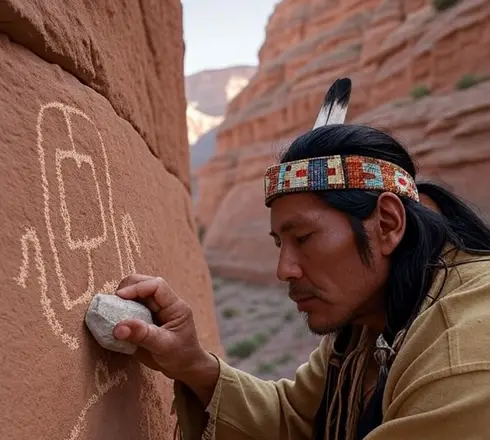 Caborca’s strategic position, 62 miles south of the U.S.-Mexico border at Sonoyta, facilitated historical trade routes and modern archaeological collaboration between Mexican and U.S. institutions. The journey to Rocky Point, 108 miles southwest, connects the inland desert to the Gulf of California, a route that echoes ancient exchange networks evidenced by coastal artifacts found near the site. The petroglyphs are part of a broader regional tradition, with nearby sites like El Mójoqui and Sierra del Álamo displaying similar rock art, suggesting a shared cultural landscape tied to the Trincheras culture, known for terraced settlements and distinctive ceramics discussed in Mexico Unexplained episode number 297.
Caborca’s strategic position, 62 miles south of the U.S.-Mexico border at Sonoyta, facilitated historical trade routes and modern archaeological collaboration between Mexican and U.S. institutions. The journey to Rocky Point, 108 miles southwest, connects the inland desert to the Gulf of California, a route that echoes ancient exchange networks evidenced by coastal artifacts found near the site. The petroglyphs are part of a broader regional tradition, with nearby sites like El Mójoqui and Sierra del Álamo displaying similar rock art, suggesting a shared cultural landscape tied to the Trincheras culture, known for terraced settlements and distinctive ceramics discussed in Mexico Unexplained episode number 297.
The site’s elevated terrain, offering expansive views of surrounding valleys, likely influenced its selection as a locus for artistic expression. Its proximity to seasonal water sources and trade corridors indicates it served as a communal or ceremonial hub, possibly for rituals or territorial demarcation. Managed today by the Rancho Puerto Blanco Ejido, La Proveedora balances preservation with accessibility, drawing researchers and visitors to explore its historical significance within the rugged beauty of Sonora’s desert.
The La Proveedora petroglyphs are a diverse corpus of iconography, categorized into anthropomorphic, zoomorphic, geometric, and phytomorphic motifs, each providing clues to their creators’ worldview. Anthropomorphic figures, often depicted with headdresses, bows, or arrows, appear in dynamic poses suggestive of hunting, dance, or ritual activities. These carvings, sometimes solitary and sometimes grouped, may represent shamans, warriors, or community leaders, reflecting social hierarchies or spiritual roles. Zoomorphic motifs include deer with branching antlers, coiled snakes, and birds resembling macaws, the latter indicating trade connections to southern regions like Oaxaca, over 1,000 kilometers away, where such feathers were prized for ceremonial use.
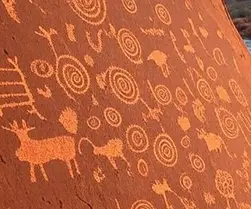 Geometric designs—spirals, concentric circles, lattices, and celestial symbols like suns and moons—are prevalent and may have served as astronomical markers, tracking solstices or seasonal cycles critical to desert agriculture. Phytomorphic motifs, depicting plant-like forms, such as trees, flowers and leaves, are less common but could relate to fertility rites or early agricultural practices. The integration of these elements defines the “Caborca Style,” a regionally distinct aesthetic characterized by the interplay of human, animal, and abstract forms, setting La Proveedora apart from other Southwestern rock art traditions.
Geometric designs—spirals, concentric circles, lattices, and celestial symbols like suns and moons—are prevalent and may have served as astronomical markers, tracking solstices or seasonal cycles critical to desert agriculture. Phytomorphic motifs, depicting plant-like forms, such as trees, flowers and leaves, are less common but could relate to fertility rites or early agricultural practices. The integration of these elements defines the “Caborca Style,” a regionally distinct aesthetic characterized by the interplay of human, animal, and abstract forms, setting La Proveedora apart from other Southwestern rock art traditions.
Interpretation remains speculative due to the absence of written records. Some researchers propose that the carvings marked ritual spaces, with trance-like figures suggesting shamanic practices potentially linked to psychoactive plants like datura. Others view them as territorial or navigational aids, delineating resource-rich zones in a contested landscape. The motifs’ variability in depth and weathering suggest multiple creation phases, from Archaic precursors to Classic Hohokam expressions. The site’s scale, with thousands of carvings across multiple panels, indicates it was a significant cultural center, possibly attracting dispersed communities for seasonal gatherings. Comparative studies with Hohokam ball courts and Chumash rock art in California highlight shared symbolic vocabularies, though La Proveedora’s specific meanings remain an open field for research.
Archaeological investigations at La Proveedora have uncovered substantial evidence illuminating its role in the Sonoran Desert’s prehistory. Surveys conducted by Mexico’s National Institute of Anthropology and History and University of Arizona researchers have documented over 5,300 petroglyphs, with estimates reaching 6,000, etched across the basalt exposures of La Proveedora and San José hills. A 2024 study formalized the “Caborca Style,” analyzing motif frequencies to link anthropomorphic headdresses and macaw imagery to Hohokam trade networks. Surface collections have revealed ceramic sherds resembling Hohokam buff wares, alongside flaked-off waste from chert and basalt tools, indicating on-site tool production and maintenance activities. These artifacts, dated through associated contexts to 600 B.C. through A.D. 1400, suggest La Proveedora was a multifunctional site, serving as a quarry, ritual space, and artistic hub.
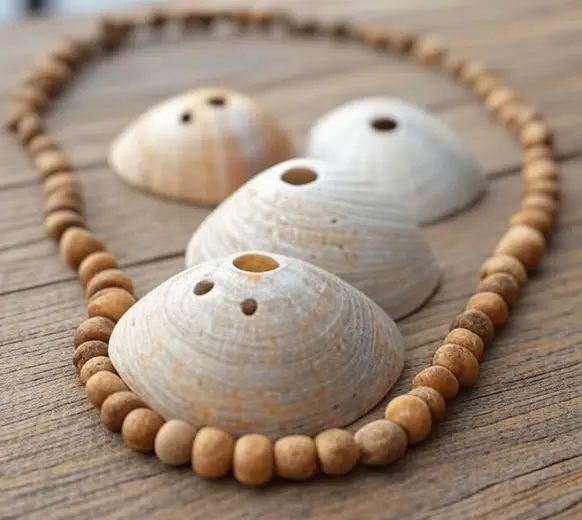 Excavations near petroglyph panels have uncovered hearth features and marine shell beads, likely sourced from the Gulf of California, 108 miles west near modern-day Rocky Point, highlighting coastal trade connections. Recent drone surveys have identified uncataloged panels, expanding the site’s known extent and revealing faint carvings obscured by a regrowth of desert varnish over the images. Non-invasive techniques, such as ground-penetrating radar, have detected potential habitation remnants, though preservation priorities limit extensive digging. The archaeological record aligns La Proveedora with nearby Trincheras culture sites, reinforcing its role as a regional center. Ongoing research seeks to apply advanced methods, like portable X-ray fluorescence, to trace material sources, though interpretive challenges—whether the site was primarily ritual or utilitarian—persist.
Excavations near petroglyph panels have uncovered hearth features and marine shell beads, likely sourced from the Gulf of California, 108 miles west near modern-day Rocky Point, highlighting coastal trade connections. Recent drone surveys have identified uncataloged panels, expanding the site’s known extent and revealing faint carvings obscured by a regrowth of desert varnish over the images. Non-invasive techniques, such as ground-penetrating radar, have detected potential habitation remnants, though preservation priorities limit extensive digging. The archaeological record aligns La Proveedora with nearby Trincheras culture sites, reinforcing its role as a regional center. Ongoing research seeks to apply advanced methods, like portable X-ray fluorescence, to trace material sources, though interpretive challenges—whether the site was primarily ritual or utilitarian—persist.
The La Proveedora petroglyphs are most closely associated with the Hohokam culture, which flourished from A.D. 300 to 1400 across southern Arizona and northern Sonora, distinguished by extensive irrigation systems spanning over hundreds of miles. The carvings likely served to commemorate agricultural cycles, trade achievements, or ancestral narratives, with motifs echoing those found on Hohokam platform mounds. Possible contributions from the Anasazi, Mogollon, or early Tohono O’odham reflect the region’s cultural interconnectedness, facilitated by its proximity to the U.S. border, 62 miles north at Sonoyta. The Trincheras culture, evident at sites like Cerro de Trincheras, 31 miles to the east, shares stylistic parallels, suggesting a regional rock art tradition.
The Hohokam’s decline around A.D. 1400, potentially due to prolonged droughts, left La Proveedora as a static archive of their legacy. Tohono O’odham oral traditions, emphasizing desert spirits and ancestral ties, may preserve echoes of these earlier practices, though direct connections remain speculative. The petroglyphs’ trade-related motifs, such as macaw feathers, underscore the Hohokam’s role in long-distance exchange networks, linking Sonora to Mesoamerica. This cultural mosaic positions La Proveedora as a critical node in understanding prehistoric social dynamics.
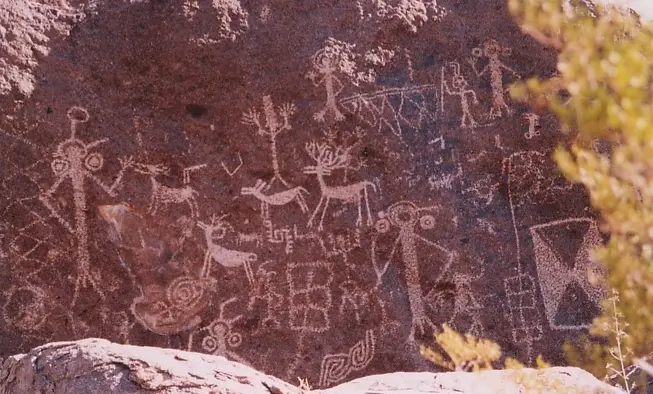 Today, La Proveedora is managed by the Rancho Puerto Blanco Ejido, which facilitates public access through guided tours, situating the site within Sonora’s heritage tourism network. Caborca, 62 miles from the U.S. border to the north and 108 miles from Gulf of California coastal resorts, serves as a hub for visitors exploring the region’s archaeological and natural attractions, including the Pinacate Biosphere Reserve. Conservation efforts, led by the National Institute of Anthropology and History, address challenges like erosion and vandalism, with digital mapping initiatives cataloging uncataloged carvings. A 2023 social media post highlighting a “Caborca Man” petroglyph—a stylized human figure—drew renewed attention, underscoring the site’s untapped research potential.
Today, La Proveedora is managed by the Rancho Puerto Blanco Ejido, which facilitates public access through guided tours, situating the site within Sonora’s heritage tourism network. Caborca, 62 miles from the U.S. border to the north and 108 miles from Gulf of California coastal resorts, serves as a hub for visitors exploring the region’s archaeological and natural attractions, including the Pinacate Biosphere Reserve. Conservation efforts, led by the National Institute of Anthropology and History, address challenges like erosion and vandalism, with digital mapping initiatives cataloging uncataloged carvings. A 2023 social media post highlighting a “Caborca Man” petroglyph—a stylized human figure—drew renewed attention, underscoring the site’s untapped research potential.
Recent scholarship, including a 2024 study, has advanced the understanding of the “Caborca Style,” positioning La Proveedora within global rock art studies. Its proximity to international research networks, facilitated by the nearby border crossing, supports collaborative efforts to document and protect the site. La Proveedora remains a vital link to the Sonoran Desert’s prehistoric past, offering both scholarly insights and opportunities for public engagement with Mexico’s cultural heritage.
